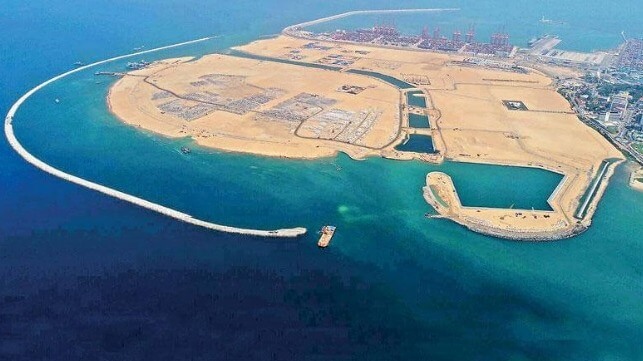China and India Compete for Influence in the Indian Ocean

[By Genevieve Donnellon-May]
Home to almost two billion people, some of the world’s most dynamic economies, and important shipping routes, South Asia is a crucial geopolitical arena and the site of increasing rivalry between two of Asia’s biggest powers—China and India.
This growing competition manifests in many areas. Despite having much in common—as rising powers with nuclear weapons and large populations alongside a shared ambition of multipolarity—India and China regard each other with suspicion.
This has led the two countries to try and contain the influence of the other, and to compete to expand into new areas of regional strategic interest in South Asia and the Indian Ocean region.
For China, greater influence in South Asia supports domestic and foreign policy goals, specifically protecting access to world markets via the Indian Ocean region’s important global maritime routes.
Aiming to challenge India’s position as the regional naval hegemon, China’s People’s Liberation Army (PLA) Navy has also built up presence in the Indian Ocean.
Furthermore, using the ambitious Belt and Road Initiative (BRI), Beijing has strengthened relations in South Asia through infrastructure investments and greater connectivity via sea, road, and rail. This also supports China’s ambition of building a ‘community of common security’ in the neighborhood.
Most of India’s South Asian neighbors—aside from Bhutan—have joined the BRI, under which Chinese investment has grown considerably through soft power and hard power. Since 2018, China has committed or invested over $150 billion in the economies of Bangladesh, Maldives, Myanmar, Pakistan, Nepal, Sri Lanka and Afghanistan. China is now the largest overseas investor in Maldives, Pakistan, and Sri Lanka.
This has worried India, which fears that China may significantly impact its own sphere of influence and even encircle India with a ‘String of Pearls’, similar to Beijing’s fears of a ‘Malacca Dilemma’.
China’s establishment of a military base in Djibouti and the Sri Lankan authorities allowing a Chinese military surveillance ship to dock at Hambantota port have exacerbated these concerns. From India’s perspective, China’s growing influence in the region has placed them in competition, pushing it to reconsider its foreign policy and engagement in the region.
It has done this by implementing a ‘Neighborhood First’ Policy in South Asia. This policy is further supported by an ‘Act East’ Policy, under which India seeks to improve relations with Southeast Asian countries and the rest of the Asia-Pacific region.
Additionally, New Delhi has extended lines of credit to five countries in the region—Bangladesh, Maldives, Myanmar, Nepal, and Sri Lanka—and also invested in infrastructure, especially in energy and connectivity. To support these efforts, Indian conglomerates like the Adani Group have greatly increased their presence in Asia aided by concessional loans for ‘strategically important infrastructure projects abroad’.
Neither China nor India’s efforts to increase their spheres of influence are without challenges. For China, the BRI has faced significant criticism for its ‘predatory’ loans and for trying to legitimize China’s authoritarian model of government and economic development.
Some note that expanding trade deficits in China’s favor, alongside the absence of strong institutional mechanisms to protect borrowers and the scale of China’s lending, pose risks for countries accepting BRI investments.
Still others argue that fears of ‘debt trap diplomacy’ are exaggerated, noting that Chinese investment nearly always faces backlash, regardless of its terms.
India’s foreign policies have also come under scrutiny. Along with territorial disputes and New Delhi’s inconsistent regional engagement, there are concerns that India may co-opt regional cooperation mechanisms to try achieve regional hegemony in South Asia.
These fears are made worse by anti-India sentiment in parts of South Asia, including in Bangladesh and Nepal, where India has been credibly accused of meddling in domestic politics. For other countries like Bhutan, close relations with New Delhi have hampered attempts to strengthen bilateral ties with other countries.
This Sino-Indian competition in South Asia stands against a backdrop of systemic China-US competition. This unstable environment offers smaller South Asian countries—who might be concerned about an asymmetry of power in India’s favor in their bilateral relationships—opportunities to use offers from China to get a better deal with India, and vice versa.
However, this risks them being drawn into regional and global geopolitical rivalries, and could lead to pressure from all sides. After all, as the example of Nepal shows, achieving a balancing act is difficult. As it stands, the geopolitical landscape of South Asia is being decided by this increasing rivalry, and how these smaller powers navigate it deserves closer attention.
Genevieve Donnellon-May is a geopolitical and global strategy advisor on regional resources and environmental governance in Asia. She is the Asia-Pacific analyst at The Red Line podcast, a researcher at the Oxford Global Society, and a 2023 CSIS Pacific Forum young leader.
This article appears courtesy of The Strategist and may be found in its original form here.
The opinions expressed herein are the author's and not necessarily those of The Maritime Executive.
No comments:
Post a Comment